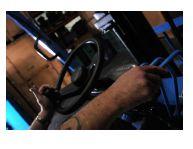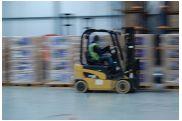Question 1: What is scaffolding?
Scaffolding is a temporary structure erected to provide a safe working platform for construction or maintenance tasks at heights.
Question 2: What are the main hazards associated with working on scaffolding?
The main hazards associated with working on scaffolding include falls from heights, collapses of scaffolding structures, being struck by falling objects, and electrocution if the scaffold is near power lines.
Question 3: How can you prevent falls from scaffolding?
Falls from scaffolding can be prevented by using guardrails, toe boards, and personal fall protection systems such as harnesses and lanyards. Regular inspection and maintenance of the scaffolding structure is also essential.
Question 4: What should you do if you notice any defects or damage in the scaffolding?
If you notice any defects or damage in the scaffolding, you should report it immediately to your supervisor or the person in charge and avoid using it until it has been inspected and repaired by a qualified person.
Question 5: How should you access and exit scaffolding safely?
Access and exit to scaffolding should be done using designated access points, such as ladders or stairs, and not by climbing on cross-braces or other parts of the structure. Three points of contact (e.g., two hands and one foot, or two feet and one hand) should be maintained at all times.
Question 6: Can you move or alter scaffolding without proper authorization?
No, you should never move or alter scaffolding without proper authorization from a qualified person, as it may compromise its stability and safety.
Question 7: How should you handle tools and materials while working on scaffolding?
Tools and materials should be properly secured to prevent them from falling or being knocked off the scaffolding. Use tool belts or lanyards to keep tools within easy reach, and never leave tools or materials unattended on the scaffold.
Question 8: What precautions should you take when working near power lines?
When working near power lines, always maintain a safe distance as per local regulations and use non-conductive materials for scaffolding. Be aware of the overhead power lines and take necessary precautions to prevent accidental contact, such as using tag lines and maintaining safe clearances.
Question 9: Is it safe to work on scaffolding during adverse weather conditions?
No, it is not safe to work on scaffolding during adverse weather conditions such as high winds, heavy rain, or snow. Scaffolding should be inspected and secured against adverse weather conditions, and work should be suspended if conditions pose a risk to workers’ safety.
Question 10: What should you do in an emergency while working on scaffolding?
In case of an emergency such as a scaffolding collapse or a worker falling, immediately raise the alarm, and follow the established emergency procedures. This may include calling for medical assistance, evacuating the area, and providing first aid to the injured person if trained to do so.
Remember, scaffolding work requires proper training, supervision, and adherence to safety guidelines to prevent accidents and ensure the safety of workers. Always follow the instructions of your employer, supervisor, or qualified person when working on scaffolding.
Download Now for FREE!!
Available only for all registered Users, does not require any payment to download.
| Title | |||
|---|---|---|---|
|
Mechanical power transmission apparatus 1 513 downloads |
Checklist, Free Files | October 21, 2022 | Please login to download |
|
Machine guarding 1 513 downloads |
Checklist, Free Files | October 21, 2022 | Please login to download |
|
HEALTH AND SAFETY MANUAL 1 13417 downloads |
Free Files, Learning/Training | October 14, 2022 | Please login to download |







